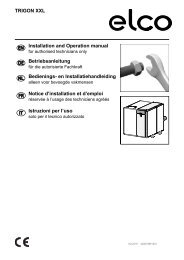Nimbus Compact M NET R32 Installation Manual UK
You also want an ePaper? Increase the reach of your titles
YUMPU automatically turns print PDFs into web optimized ePapers that Google loves.
Decommissioning<br />
8. Decommissioning<br />
Prior to performing this procedure, it is imperative for the technician<br />
to fully understand the equipment and all its details.<br />
We recommend recovering all the refrigerants safely.<br />
Prior to performing the activity, a specimen of the oil and refrigerant<br />
must be drawn if these substances must be analysed<br />
before the recovered refrigerant is used again.<br />
Electricity must be available before the activity starts.<br />
Familiarise with the equipment and its operation.<br />
Isolate the system electrically.<br />
Before proceeding:<br />
– Make sure that all personal protective equipment is<br />
available and is used correctly.<br />
– Make sure that the recovery process is always supervised<br />
by a competent person.<br />
– Make sure that the recovery equipment and the cylinders<br />
conform to the appropriate standards.<br />
8.1 Draining the circuit and recovering the<br />
refrigerant<br />
To correctly recover the refrigerant from the system, the following<br />
standard indications must be observed:<br />
– When the refrigerant is transferred to the cylinders,<br />
make sure that only appropriate refrigerant recovery<br />
cylinders are used. Make sure that the correct number<br />
of cylinders is available for maintaining the system’s<br />
total charge. The cylinders must be complete with the<br />
pressure limiting valve and the relative shut-off valves in<br />
efficient working order. The vacuum recovery cylinders<br />
must be drained and, if possible, cooled before the recovery<br />
operations begin.<br />
– The recovery equipment must be in good working order.<br />
Moreover, a set of calibrated scales must be available<br />
and in good working order. The flexible hoses must<br />
be complete with the disconnection joints without<br />
leakages and in good working order. Before using the<br />
recovery machine, check that it is in efficient working<br />
order, that it has been adequately serviced and that all<br />
the associated electrical components are sealed to prevent<br />
ignition in case of refrigerant leakages. Contact the<br />
manufacturer in case of doubts.<br />
– The refrigerant recovered must be returned to the refrigerant<br />
supplier in the correct recovery cylinder and<br />
the relevant waste transfer note must be drawn up. Do<br />
not mix the refrigerants in the recovery units and, above<br />
all, in the cylinders.<br />
– If the compressors or the compressor oils must be removed,<br />
make sure that they have been drained to an<br />
acceptable level so that no flammable refrigerant remains<br />
inside the lubricant. The drainage process must<br />
be carried out before returning the compressor to the<br />
suppliers. Only the electrical heating of the compressor<br />
body must be used to speed up this process. Whenever<br />
oil is drained from a system, the procedure must be carried<br />
out in safe conditions.<br />
i<br />
i<br />
i<br />
Equipment shall be labelled stating that it has<br />
been de-commissioned and emptied of refrigerant.<br />
The label shall be dated and signed.<br />
For appliances containing flammable refrigerants,<br />
ensure that there are labels on the equipment<br />
stating the equipment contains flammable<br />
refrigerant.<br />
78 / EN

















